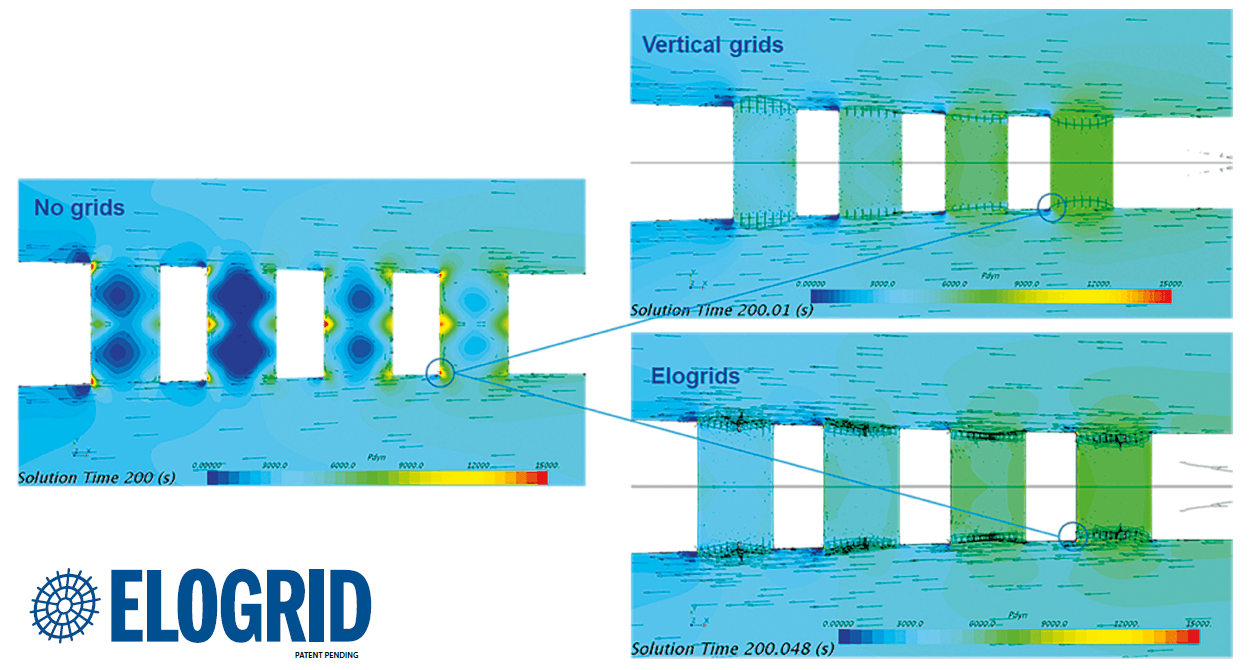11/08/2020
Improving ship hull hydrodynamics
ELOGRID utilised in bow thruster tunnel openings
Ship hulls are equipped with thrusters that allow lateral ship motion, for example, in harbour manoeuvring. The propellers that induce the force are mounted inside tunnels in the bow section or, in some cases, in the stern section. These tunnels increase ship resistance, which can be reduced with the use of grids set in the openings.
Thruster tunnels are necessary to improve ship manoeuvring but adding these tunnels to a nicely shaped ship hull can contribute to additional resistance, which is reflected in ship fuel consumption.
The additional fuel consumption depends on the hull shape and varies from 1 % per tunnel to 3 % per tunnel. In some cases, the additional resistance contributed by the tunnels can be as high as 10 % of the ship hull’s total resistance. This means that a relatively large amount of money will be spent on fuel while also producing additional CO2 emissions.
The additional resistance can be reduced with the use of vertical grids set orthogonally to the streamlines close to the hull surface.
With good dimensioning, these vertical bars can decrease the additional resistance from tunnels easily by 50 %, which results in noticeable improvements in fuel economy. A drawback of such vertical grids is that they reduce thrust forces up to 10 %. The vertical bars work as stators in two narrow sectors of the circular flow path, and mixers in most of the opening. The blade profiles are not designed to increase the thrust forces and static pressure is elevated on the wrong side of the blades.
ELOGRID
A new grid design fr thruster openings has been developed in order to reduce the additional resistance from tunnels while at sea and to improve the thrust forces induced by the propeller when manoeuvring.
The additional resistance is decreased, in principal, in a similar way as with vertical grids. The turbulence length scale at ship service speed with the boundary layer development speed determines the distance of the plates needed to prevent main bulk flow entry into the tunnel surfaces. Most of the tunnel resistance is created by pressure forces contributed by the flow into the tunnel.
The thrust forces are increased using the grid stator effect. The propulsion induces swirling with higher circumferential velocity, which is decreased and aligned more axially with the use of stator blades. At the same time, the static pressure is elevated resulting in improved thrust forces on the ship hull.
Instead of causing forces that work in the opposite direction than propulsion, ELOGRIDs are designed to produce thrust forces that work in the same direction as propulsion. That is made possible with radial blade profiles designed keep the boundary layer attached to the blade suction side.
When stator blades are designed to provide thrust forces, instead of reducing them – the thruster capacity can be elevated. Compared to open tunnels, the additional forces can be 5 %, and compared to conventional grids with a 10 % handicap, the addition can be as much as 15 %.
Considering ship performance, this update to tunnel openings provides lower fuel consumption at sea and improved manoeuvrability in harbours. The better manoeuvrability is available at higher wind speeds, and results in faster turning times. Dynamic positioning can be improved, and the elevated propulsion efficiency produces less noise. In newbuilds, the grids allow smaller thruster sizes as well in some cases.


Juha Tanttari
M.Sc (Mech. Eng)
Juha Tanttari has 20 years’ experience of working in fluid dynamics consulting. His experience covers a vast range of industrial segments including marine hydrodynamics and aerodynamics, project management and sales. He is currently of Lead Consulting Engineer, in Technical Analysis.
juha.tanttari@elomatic.com
Want to know more? Check out these related articles:
Elogrid
Elogrid is a cutting-edge solution crafted by our team, dedicated to maximizing energy efficiency and minimizing environmental impact in maritime operations. By seamlessly integrating advanced engineering methods and innovative design principles, Elogrid offers a multifaceted approach to enhancing vessel performance.
Shipowners and Operators
We develop innovative solutions that can minimize the environmental impact and operating costs of your ships.

